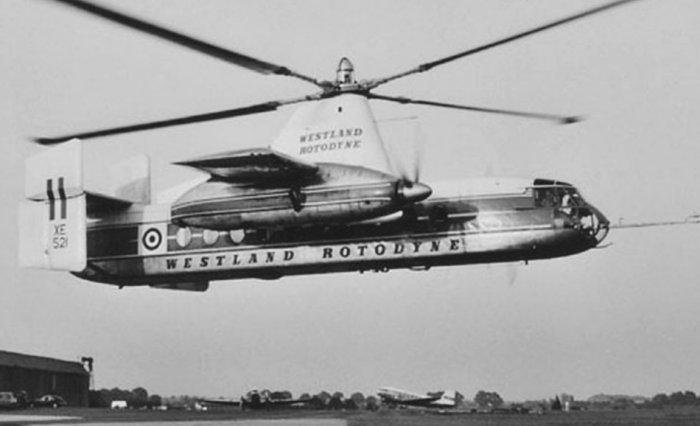 The 1957 Fairey/Westland Rotodyne, part plane part helicopter.
The 1957 Fairey/Westland Rotodyne, part plane part helicopter.
Why were compound helicopters not successful ?. This question is quite a debate.
First, Why compound? and the answer is of course to achieve higher speeds by providing extra thrust. But with the higher speeds come the problems of retreating blade stall and increased rotor stress.
Generally, the way around this has been to offload the rotor by adding a wing. However you immediately pay a price in that you degrade the hover performance.
Even with compounding, you are unlikely to achieve cruising speeds higher than 450kph, which can be achieved by fixed wing much more economically, and in any case conventional helicopters can already fly at speeds of 300kph without difficulty.
The strength of the helicopter lies in its ability to hover efficiently, so to interfere with that and add the complexity which compounding is bound to introduce, must call for a good reason.
To say that compounds have not been successful is not strictly true. The Fairey Rotodyne achieved all its technical targets, but it must be admitted that it was expensive.
The Lockheed AH-56 Cheyenne demonstrated high manoeouverability and was capable of nearly 400kph. The Kamov Ka-22 exceeded 365kph. And of course the V-22 Osprey is a compound which can achieve very high speeds, and shows every sign of a bright operational future.
There are roles where compounding looks attractive:
 Aiborne Early Warning is an example where you only hover for take off and landing and otherwise spend the whole flight in the criuse which is very efficient for a compound.
Aiborne Early Warning is an example where you only hover for take off and landing and otherwise spend the whole flight in the criuse which is very efficient for a compound.
 The same applies for short haul transport, but city centre operation is a problem and once an airfield is involved the helicopter loses its advantage.
The same applies for short haul transport, but city centre operation is a problem and once an airfield is involved the helicopter loses its advantage.
 Search and Rescue, Attack, Anti-submarine, Police and Air Ambulance all call for prolonged hover and low speed operation, where the compound is at a dis-advantage.
Search and Rescue, Attack, Anti-submarine, Police and Air Ambulance all call for prolonged hover and low speed operation, where the compound is at a dis-advantage.
Personally, I do not think the age of the compound is with us yet, but as technology progresses there may yet be a break through.
First, Why compound? and the answer is of course to achieve higher speeds by providing extra thrust. But with the higher speeds come the problems of retreating blade stall and increased rotor stress.
Generally, the way around this has been to offload the rotor by adding a wing. However you immediately pay a price in that you degrade the hover performance.
Even with compounding, you are unlikely to achieve cruising speeds higher than 450kph, which can be achieved by fixed wing much more economically, and in any case conventional helicopters can already fly at speeds of 300kph without difficulty.
The strength of the helicopter lies in its ability to hover efficiently, so to interfere with that and add the complexity which compounding is bound to introduce, must call for a good reason.
To say that compounds have not been successful is not strictly true. The Fairey Rotodyne achieved all its technical targets, but it must be admitted that it was expensive.
The Lockheed AH-56 Cheyenne demonstrated high manoeouverability and was capable of nearly 400kph. The Kamov Ka-22 exceeded 365kph. And of course the V-22 Osprey is a compound which can achieve very high speeds, and shows every sign of a bright operational future.
There are roles where compounding looks attractive:
Personally, I do not think the age of the compound is with us yet, but as technology progresses there may yet be a break through.
